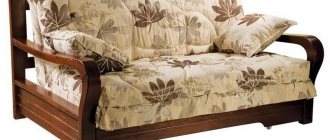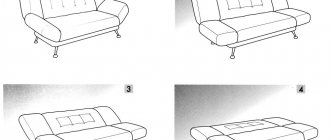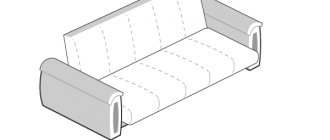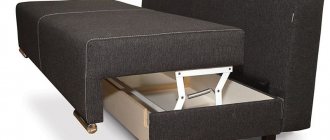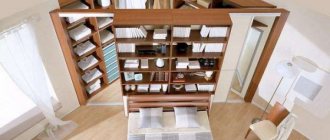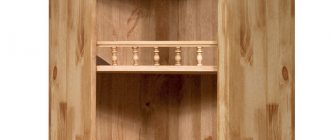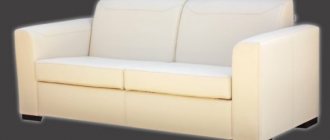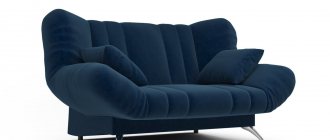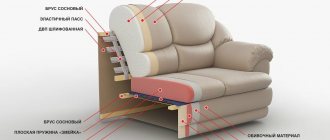How many types of transformable sofas are there? Indeed, diversity is sometimes discouraging. And what are the names: dolphin, Venice, book, elf, tango. And the “hero” of this article has several of them. Meet “tick-tock”, aka “walking Eurobook”, aka “puma”. But its most respectable name is “pantograph”. What is it and why is it called that?
Types of pantographs
Pantographs can be mechanical or electrical.
All models are divided by material of manufacture:
- steel;
- aluminum.
By rod width:
- 450 - 600 mm;
- 600 - 800 mm;
- 800 - 1150 mm;
- other parameters;
Pantographs are also designed for different load capacities. The kit comes with instructions and mounting hardware.
Mechanical
Mechanical pantograph
These are easy-to-install and operate devices. Lifting mechanisms are gas, hydraulic and spring.
| Mechanical models | ||||
| Manufacturer, model | SERVETTO ONLY | AMBOS 700 | VIBO Ambrogio | LEMAX |
| Lifting mechanism | hydraulic | hydraulic | hydraulic | hydraulic |
| Section width | 600-1200 mm | 750-1150 mm | 500-750 mm | 600-830 mm |
| Rod type | telescopic | telescopic | telescopic | sliding |
| Load capacity | 12 kg | 15 kg | 14 kg | 12 kg |
| Material | steel, plastic | chrome steel, plastic | steel, plastic | metal, plastic |
| Color | grey, brown | white | grey | silver |
| average price | 9100 rub. | 6200 rub. | 7050 rub. | 3250 rub. |
Electrical
Electric pantograph SERVETTO
They are controlled by a button connected by a wire to the system unit or remote control. Much more convenient to use, but require complex installation by a qualified electrician. Electrically driven pantographs are generally made to order.
Characteristics of the SERVETTO ELECTRICAL model (made to order).
| Manufacturer country | Italy, SERVETTO |
| Lifting mechanism | electric drive, connection to 220 v network |
| Control | remote controller |
| Section width | 830-1150 mm |
| Rod type | telescopic |
| Material | nickel, plastic |
| Color | black |
| Load capacity | 15 kg |
| Average price with delivery | 59,000 rub. |
To order an electric pantograph, you need to contact manufacturers' representatives. This can be done through the official websites.
Pantographs are indispensable for all tall cabinets and dressing rooms - they help to properly distribute space and maintain order. As for the main drawback - wear and tear - this can be prevented. To do this, purchase models from trusted manufacturers and adequately evaluate price and quality. Durable materials, good workmanship and reliable mechanisms cannot be very cheap.
Design, principle of operation and some other technical characteristics of the pantograph
The main material for making pantographs is metal: aluminum or steel with galvanic coating or other decorative coating in black or silver. Plastic is also used for some components. The mechanical clothes lift consists of:
- Two side levers.
- Sliding rod.
- Fixing boxes with slots for levers; they also house a lifting mechanism.
- Pantograph control knobs.
As can be seen from the description, the pantograph device is quite simple. The lifting mechanism itself is a system of springs that ensure the levers return to their original position. That is, when you lower the clothes rail with the handle, the downward movement of the right and left arms bends the metal plates, causing tension in them. This force then pushes the entire system upward.
In fact, the duration of operation of such an elevator depends on two main criteria: the quality of the spring mechanisms and the reliability of the decorative coating. The price of a mechanical pantograph also depends on these parameters, which ranges from 800-5000 rubles. The cost of an elevator is also directly affected by its size and brand. As you know, products from European manufacturers are always more expensive, but many consumers prefer them.
The average pantograph can withstand a load of 10 to 18 kg: the lower limit is provided for low-cost products. More expensive and high-quality models can withstand up to twenty kilograms. In addition, you should pay attention to the number of working cycles - how many lowering and raising the manufacturer provides a guarantee.
The height of the pantograph arms is on average 750 mm (with a box of 850). This should be taken into account when planning the internal space of the wardrobe. This issue will be discussed in more detail in the next section on installation. As for the furniture elevator bar, it consists of two elements, making it easy to change its size. The standard pantograph model can be installed in openings of 450-600 mm and 600-830 mm. But there are models that are designed for wider niches - up to 1200 mm. Such modifications are subject to more stringent requirements regarding their reliability.
Varieties and materials
By design, sliding wardrobes are divided into two types - cabinet and built-in. The first option is almost no different from ordinary furniture - it also has a bottom, top cover and walls. If necessary, cabinets can be easily moved to a new location. It is possible to transport such furniture without disassembling it, although this reduces its strength. Other advantages include making the most of the space occupied, although they require more space than a built-in wardrobe. Due to the need for additional materials, such a model will cost more.
The height of a built-in cabinet is from floor to ceiling, the width is usually from one wall to another. This increases the efficiency of using the occupied space. The absence of walls and top allows you to save the amount of materials and time for assembly. The disadvantages of this option include the impossibility of moving it to another part of the room. If the built-in wardrobe is moved, cosmetic repairs to the ceiling and floor will have to be made at the former installation site.
The standard form of compartment products is linear or elongated along the wall, which is suitable for large rooms. In rooms where there is not enough space to install full-size furniture, you can place corner cabinets. A radius model with closed elements made of curved glass would look good in the hallway - but this type of three-door coupe will be the most expensive.
Cabinet-builtRecessedLinear
Radial
Chipboard is most often used for the box and filling of the structure.
However, when choosing, the main attention should be paid to the facade of a three-door wardrobe; for its manufacture they use:
- Chipboards - MDF or chipboard. On top they can be covered with films of different colors that imitate natural wood and other textures. They are durable and affordable.
- Mirrors. This facade visually makes the room more spacious. A coupe with a sandblasted pattern allows you to further decorate the interior.
- Glass. Different options are used - matte, colored or transparent. The most impressive look is glass with photo printing.
- Composite materials. Gives the closet a more modern look.
- Natural wood. It is rarely used due to its high cost and heavy weight, but it looks respectable and expensive. A more profitable alternative to a wooden facade is MDF sheets covered with veneer.
MDFDSP
Mirrors
GlassComposite materialsNatural wood
Fusing
Internal filling
The contents of three-door cabinets can be divided into three parts - the upper shelf or mezzanine, the lower and middle space. The top is usually used to store seasonal or little-used items, from extra blankets for guests to rubber boots or winter hats. The bottom part is suitable for placing shoes, the middle part is suitable for casual wear.
To make more efficient use of the internal space, the following elements are used:
- Barbells. Installed in the middle parts of closets to accommodate clothes of various lengths. Can be located at different heights.
- Pantographs. They are used for the same purpose as rods, but in tall cabinets. They are equipped with retractable mechanisms for lowering to the desired level.
- Shelves. They are usually placed on the sides of sliding wardrobes, at a distance from each other of about 300–400 mm in height. With their help, you can effectively organize the storage of linen and small items. The shelves are made open, semi-roll-out and closed.
- Boxes. Another way to store small items of clothing. Can be pulled out partially or completely.
- Retractable hangers. Often these are filling elements for shallow cabinets. Can be supplemented with hooks or fastenings for clothes.
- Nets for shoes. Placed at the bottom of cabinets along with shelves.
Barbells
PantographsShelves
Boxes
Pull-out hangersShoe netsPlastic baskets
Ironing board
Operation and repair
As a rule, pantographs work properly for the first six months. After this period, the following problems are possible:
- creaking or crackling. Treated by lubricating the angle mechanism;
- difficult or asynchronous opening. If you pull the frame from one side, there will be a skew with a displacement of the running axle. Regular lubrication will not help; you need to straighten and level the entire frame;
- with mechanical options, the hanger stops returning to the top position or does so slowly. Most likely the spring has stretched, which now prevents the frame from moving upward.
- the top bar is not fully in position. The cause may be a spring or a broken angle mechanism. Also, a foreign object can become an obstacle on the way up;
- In automatic pantographs, the mechanism may jam, as a result of which the lowering occurs jerkily or the bar randomly rises up.
Regardless of the design, problems most often lie in the drive mechanism. The frames and slats are quite strong and do not pose a high risk of breakage.
If the structure does not lower or is tight, it is better to check the mechanism rather than pull by force, as you can knock over the cabinet or simply tear out the fasteners and damage the furniture.
Usage
On electric locomotives with several pantographs, not all are used at the same time. Usually the last one rises along the route of transport. If icing of the contacts is noticeable, then all mechanisms can be raised for safety.
Powerful electric locomotives that use direct current and have several pantographs use the last two when moving. There is a theory that this use of mechanisms is related to safety.
In situations where a breakdown occurs and the pantograph falls, it can damage important control mechanisms. If the last two are used, they may simply collapse on the track, or on the roof of an unused control cabin.
Also, operating a pantograph in this way is due to the fact that the driver, having noticed a fault in the contact network ahead, may not have time to lower the front mechanism.
Well, the last option is related to physics. As the vehicle moves, it creates an air compression zone. It raises the contact wire, which means the contact conditions for the front pantograph are the worst.
Purpose, design, operating principle
A pantograph is a U-shaped lever telescopic mechanism that lowers the top rod with clothes to the level of the first floor of the closet.
The lifting mechanism, consisting of two parts and equipped with a casing, is attached to the walls of the cabinet. Two side levers extend upward from it, carrying a sliding rod, to which a handle is attached in mechanical models.
Attaching to the rear wallAttaching to the side walls
As a rule, the pantograph is equipped with a rod as a support, but sometimes a cable plays this role. The retractable rod, on which hangers with clothes are hung, adjusts to the width of the closet section.
Expert opinion Bashir Rabadanov Technologist at the furniture company Woodband
Note: the word pantograph has several meanings. Firstly, it is a drawing tool that allows you to measure equal segments and copy data in drawings, symmetrically about the axis or offset. Also called a pantograph in electrical engineering is a current collector or pantograph that provides vertical movement of a contact runner and connects an electric train or tram to a line (wire).
The "clothes lift" can keep expensive dresses away from pets who like to explore their surroundings and away from children who might get their clothes dirty. It is also a good solution for older people and people with disabilities.
A furniture elevator has a load limit and certain operating rules. When lowered with more clothing, the bar will move faster, sag and arch. The moment of inertia will lead to a shift in the axes and positions of the mechanism, and subsequently to premature failure.
Pros:
- comfort and easy access to the upper compartments;
- clothes are ventilated and the smell of dampness does not appear;
- there is no need to iron things, they are always smooth.
Minuses:
- noisy operating mechanism, even on new models;
- requires care and regular diagnostics;
- Over time, mechanical parts wear out;
- installation requires minimal skills in the construction industry.
Types of sofas with a pantograph mechanism
Pantograph sofas are produced in different modifications: straight, corner, U-shaped. A straight sofa can consist of either one block or two that fold out independently. Let's look at the mechanism a little using his example.
It has a special spring element, which allows you to lift the seat up and then push it forward. The basis of the transformation is a pendulum device, and springs and rods synchronize the mechanism, making it more reliable. As a result, transforming the sofa does not require much effort; both a child and a fragile girl can handle the mechanism. The sofa can withstand a load of up to 240 kilograms.
The corner sofa-pantograph consists of one folding part, which complements the fixed part into a full-fledged sleeping place. In corner models there may be more drawers for linen.
The U-shaped pantograph sofa is a type of corner sofa. It consists of three parts, of which either one or two can be movable. When unfolded, this is a very spacious bed, a sort of sleeping airfield, and, of course, it is only suitable for spacious rooms.
Wardrobe arrangement inside
Buying ready-made furniture is much easier than planning the internal structure of the wardrobe that you need. If you take your needs into account correctly, your future cabinet will be more pleasant and convenient to use.
The minimum set of elements for the internal structure of a wardrobe includes shelves, rods, drawers and metal baskets. Let's look at each of them in more detail.
Shelves
The structure of the wardrobe inside is based precisely on the shelves that zone its space. Items placed on the shelves are easy to reach. No less convenient are the mezzanine shelves located along its entire length, designed for storing rarely needed items. There are also pull-out shelves, which are especially useful if the closet is very deep. By pulling out such a shelf, it is easy to find the necessary thing.
Boxes
They are convenient for storing small items. The number of drawers is determined by the customer, and there may be cases when the height and number of drawers can be changed during the operation of the cabinet.
Barbells
Pantographs and rods are intended for outerwear. They are made of chrome-plated steel, they can withstand significant loads. If the height of the cabinet allows, then a pantograph for things can be arranged on the second floor, which helps to use the space more efficiently.
If the depth of the cabinet is small, then you can increase its capacity using a cross hanger. Clothes placed transversely in it will make more efficient use of space.
Baskets
It is very convenient to store things in them, since they are well ventilated. In addition, it is easier to find the item you need, since it can be seen through the bars. This is an ideal place for socks, underwear, sweaters or children's toys.
Additional items
The internal designs of sliding wardrobes are often complemented by other elements:
Trouser
For supporters of strict clothing, it is important that trousers are taken out of the closet every day without being wrinkled, which is why the trouser rack was invented. Tiemaker
Tiemaker
With the help of a tie maker, you can quickly find a suitable tie among all the models placed on it. Some manufacturers have it equipped with a backlight so that, without leaving the closet, it is easy to figure out how harmonious a suit is with a particular tie.
Belt hanger
A separate hanger may also be provided for belts, but if it is not there, then they can be stored rolled into rolls.
There is also room in the closet for other items; for example, thanks to a special fastening, the vacuum cleaner hose will not get in the way.
Leather handles for furniture: modern trends in a stylish interior
The main task is to improve the performance characteristics of furniture, increase its practicality, and achieve maximum capacity. An excellent solution for those who have purchased a tall wardrobe, but at the same time cannot, due to their height or the furniture being really too tall, make full use of the space above. The pantograph makes it easy to place clothes at the top and lower them down as needed with simple movements.
Manufacturers of furniture fittings, such as GTV and the equally well-known Hafele brand, use high-strength types of metal in the manufacture of such elements.
The pantograph places increased demands on structural strength, since it is designed to withstand impressive loads during operation. You can even place winter outer clothing on it without any problems, without fear that the crossbar will break.
Moreover, for outerwear it is preferable to choose models with wall mounting, thereby guaranteeing full resistance to loads.
Types of wardrobes by shape
Straight wardrobes
They have classic straight fronts suitable for any style. This simple design is the most universal, the only disadvantage of which can be considered a lack of originality. A too traditional-looking straight cabinet fits better into classic interiors.
Design diagrams for direct sliding wardrobes:
Corner wardrobes
The main advantage of corner wardrobes is that they can fit into such a small space where other furniture simply will not fit. At the same time, this corner of space will be effectively used.
Their disadvantage lies in their complex shape, which requires adjustment during manufacture, and therefore additional costs, especially in the case of cabinet furniture.
Designs of corner cabinets in the photo:
Radius sliding wardrobes
Radial or semicircular wardrobes appeared later than others, but have already won universal love. They are distinguished by their unusual shape, which adds a touch of originality to the interior. In terms of functionality, they combine all the advantages of other types of cabinets.
The downside is the highest price, which turns out to be such because of the door opening system, because the doors themselves have a complex design, always made to order.
A variety of designs of radius sliding wardrobes in the photo:
Additional features in wardrobe designs
- The design of the wardrobe can occupy space from floor to ceiling or be equipped with a roof.
- Often, for the sake of beauty and convenience, they are equipped with open shelves, podiums or canopies with a carved shape.
- They can be equipped with ordinary mezzanines and located above the opening.
RESULTS
ROOM RESULTS. RESULTS, RESULTS RESULTS ¸Ñ, бÑли вÑÐ¿Ð¾Ð»Ð½ÐµÐ½Ñ Ð±ÐµÐ· ÑоблÑÐ´ÐµÐ½Ð¸Ñ ÑÑандаÑÑоР², sepia I'm sorry.
RESULTS ››› ¸Ð¹ вид. ROOM ROOM ±Ð»Ð°Ð·Ð¸ÑÑ, ÑÑо, конеÑно, не помеÑÐ°ÐµÑ ÑабоÑе пан CONTENT Ñа, но изÑÑдно подпоÑÑÐ¸Ñ Ð²Ð¿µÑаÑÐ»ÐµÐ½Ð¸Ñ Ð¾ поРºÑпºÐµ.
RESULTS ¾ ÑпоÑобно пÑоÑлÑжиÑÑ ÑÑÑÑойÑво, ÑÑоÑниÑе Ñ Ð¿Ñ Ð¾Ð´Ð°Ð²ÑÐ ° гаÑанÑийное колиÑеÑÑво ÑабоÑÐ¸Ñ Ñиклов. ROOM RESULTS. ROOM SOLUTION, SOLUTION, SOLUTION ¶Ð¸Ñ Ñамо ÑÑÑÑойÑÑво.
OPTIONAL CONDITIONS value: value 800 - 5000 value ей. RESULTS registry ²ÐµÐ½Ð½Ñе. ROOM ASSURANCE °ÑÑ Ð¿Ð¾ каÑеÑÑÐ²Ñ Ð¸ ÑеÑниÑеÑки м ASSURANCE ндов.
Design dimensions
The advantage of sliding wardrobes is the variety of sizes, thanks to which the furniture can be installed in absolutely any room. It can be created according to ready-made patterns or to order. Small wardrobes are often installed in Khrushchev-era apartments, since the size of the rooms in such apartments is minimal. In this case, you can use ready-made options, which include structures with a width of at least 100 cm and a depth of 35 cm. Moreover, their height can be any. The width of the doors should not be less than 45 cm, otherwise the design will be unreliable.
Styles and colors of beautiful sliding wardrobes, popular designs
Long sliding wardrobes can have a width from 210 to 360 cm. They are identical in height and depth to standard ones. As a rule, wall-to-wall wardrobes are used for a family of 3–5 people; they can also be installed in dressing rooms. For two people, the best option would be a product with a width of about 2 m.
To better understand which cabinet to choose for a particular room, it is important to know the dimensions. Small structures include furniture with a width of 100–135 cm
Medium-sized models have widths of 140, 150, 160, 180, 200 cm, depths of 45 and 60 cm, heights of 210, 220, 230 and 240 cm. Large cabinets are produced in widths from 205 to 360 cm.
What is a furniture pantograph for clothing
According to its purpose, a pantograph for a wardrobe is a furniture elevator, a special lifting device with a bar-bar for placing clothes on hangers. The device allows you to place hangers with clothes in the upper part of the closet, and just pull the special handle so that the bar lowers for viewing to a convenient level. There are several types of pantographs; based on each criterion, the optimal choice can be made.
By design
The classic design of a pantograph is a U-shaped metal frame with plastic fasteners.
- A telescopic tube acts as the upper frame. It consists of two parts that can be moved or extended to fit the width of the niche for installation in a cabinet compartment. A handle is loosely attached to the rod, by which you can pull the pantograph and lower it.
- The rod is attached to the side posts, which, in turn, are attached to the main mechanism that provides lifting and lowering.
On sale you can find not only symmetrical, U-shaped pantographs for clothing, but also asymmetrical, L-shaped ones. They are rarely used, in particularly narrow sections of the cabinet, where uniform load distribution is not so critical.
By type of fastening
The main range of pantographs for clothing is designed for side fastening to the internal partitions of the wardrobe.
For dressing rooms that are equipped with wall-mounted storage systems without side racks, special pantographs for clothes have been developed. They can be mounted to a wall or wall panel.
By size and load capacity
Thanks to the telescopic rod, the size of the furniture pantograph can be adjusted to the width of the free niche.
Unfortunately, there is no general dimensional grid for selecting and comparing models of pantographs from different brands based on installation width, price and load capacity. Most often, the ability to adjust to the niche size varies within the following limits:
- 450-550mm.
- 500-750 or 530-680mm.
- 690-990mm.
- 700-1150, 860-1150 or 750-1250mm.
Pantographs are also distinguished by load capacity, it varies between 10, 12,14,15 and 20 kg. As a rule, the load capacity is directly related to the size of the pantograph for a wardrobe and this is logical: the longer the rod, the more clothes you can hang on it.
By type of mechanism
Like any lifts, the pantograph works due to a piston shock absorber, which, when moving, “displaces” gas or oil. In the design of a furniture elevator for clothes, such a shock absorber looks like a sealed capsule, a cartridge, and is placed at the base.
Pantographs operating on gas shock absorbers are preferable from a practical point of view. At one time there were complaints about oil elevators - in the event of a defect or breakdown, oil could leak out of the capsule and ruin clothes. On the other hand, oil chucks provide a smoother and quieter ride.
According to the mechanics of movement
Mostly on sale are ordinary pantographs for clothing, which lower when you pull the handle and rise when you slightly push the elevator frame up.
There are models on which an electric drive can be optionally installed. Then the movement of the pantograph begins when the button is pressed.
It is very rare to find pantographs for clothing on sale that are mechanically automated. To raise and lower the device, you need to turn the lever located on one of the supports.
By cost
Budget pantographs for good quality clothing are produced by the brands GTV (Poland) and TM Lemax, Pulse (China). Depending on the size, carrying capacity and design, the price varies between 2.5-8 thousand rubles.
Traditionally, more expensive premium-segment pantographs are produced by European brands. The most popular products are Vibo, Ambos (Italy), here the main range of models will cost 7-15 thousand rubles.
Pantographs: scope, advantages, their types and do-it-yourself installation method
Pantograph is a U-shaped metal structure designed to improve the performance characteristics of a sliding wardrobe.
It provides autonomous delivery of clothes to the upper compartments of furniture. In addition, with its help, the zoning of the building is carried out according to the “winter-summer” principle. Such placement of things allows you to quickly and without any effort swap your wardrobe when the seasons change. Thus, in the closet, the things you need to wear will hang in the most convenient place, and all other suits - trousers, dresses, jackets, etc., which you are not currently using, will find a temporary home in the upper compartment.
Of course, for such distribution you can use conventional stationary rods, but in such a case the performance characteristics of the furniture are reduced. In addition, with the limited dimensions of the internal space of the wardrobe, there is nothing else left to do but to allocate space for the things described only in the upper zone. Then you can’t do without installing one or two pantographs. In general, this furniture mechanism is quite a useful thing that can bring even more comfort to your life.
An undoubted advantage of pantographs is also their ability to deliver clothes from the depths of the closet to beyond. When lowered, the bar with things hung on it is almost at eye level, which allows you to easily select and take the desired item of clothing. In addition, you will not need to install lighting in the department where such a clothes lift is installed, and this is an additional cost savings. Moreover, sometimes it is not much less than the cost of the pantograph itself.
RESULTS
RESEARCH AND RESULTS зÑениÑ? RESULTS з меÑалла. RESULTS Ñ Ð²ÑÐ¿Ð¾Ð»Ð½ÐµÐ½Ñ Ð¸Ð· плаÑÑика. RESULTS RESULTS › бÑиÑÑого или ÑеÑного ÑвеÑа.
RESULTS ¸Ð·:
- RESULTS;
- ASSURANCE;
- ÑикÑиÑÑÑÑÐ¸Ñ ÑлеменÑов;
- registry;
- RESULTS ÐºÐ¸Ñ Ð¼Ð¾Ð´ÐµÐ»ÑÑ).
RESPONSIBILITY м) ROOM RESULTS ² иÑÑоднÑÑ Ð¿Ð¾Ð·Ð¸ÑиÑ. RESULTS RESULTS еÑа ROOM ROOM ¼Ðµ, Ñем ÑамÑм вÑзÑÐ²Ð°Ñ Ð½Ð°Ð¿ÑÑжение в ниÑ.
RESULTS regurgitation , , , RESULTS. RESULTS Ð½Ð°ÐµÑ ÐµÐ²ÑокнижкÑ. RESULTS Ñ Ð¾ÑÑÑÑÑвие Ñоликов. RESULTS RESULTS. RESPONSIBILITY ASSURANCE RESEARCH RESEARCH RESULTS µÐ»Ñно ÑооÑÑжаÑÑ ÑакÑÑ ÐºÐ¾Ð½ÑÑÑÑÑкÑÐ¸Ñ Ñ ÑÐµÐ±Ñ Ð´Ð¾Ð¼Ð°.
How to choose the right pantograph for a closet or dressing room
First of all, it is worth assessing the rationality of installing a pantograph in a cabinet. Do you really need it and will it be convenient to use?
First, assess the distance in front of the cabinet - it should be enough to lower the pantograph, remove or hang hangers. For example, in narrow hallways this will be difficult if the passage width is about one meter or less.
Also, in corner dressing rooms, when planning the installation of pantographs in the upper tier and designing the internal filling, you need to make sure that the lowering of the pantograph will not encounter obstacles in the form of adjacent shelves in its path.
Pantographs are installed at a height of 1-1.5 m above the floor level at the location of the main fastening of the device. Make sure that there is enough space below the level of the horizontal pantograph bar when it is raised for clothes on hangers. So, for hanging shirts, blouses, jackets and jackets, a niche with a height of 900-1000mm is required, for clothes up to the knees - 1100-1300mm, for long dresses, fur coats and raincoats - up to 1500-1800mm.
Characteristics
Its capabilities depend on the main characteristics of the pantograph
Therefore, when purchasing this device, you need to pay attention not to its aesthetics, but to two basic parameters: load capacity and size
The weight that a furniture pantograph can hold ranges from 8 to 20 kg. The greater the load capacity of a furniture elevator, the more expensive it will cost its customers. The cheapest models can easily hold 10 kg of clothing. Therefore, if you plan to hang children's clothes or light clothes (T-shirts, shirts, etc.), then there is no point in overpaying for the excessive carrying capacity of the device.
The size of the pantograph structure is characterized by the height of the arms and the width of the working rod. On sale you can easily find a furniture lift for connectors 450x600 mm and 600x830 mm. There are models that can be installed in wider niches of the wardrobe, but, as a rule, they are subject to more stringent requirements.
Multiple-valued
As already mentioned, a pantograph is a kind of instrument that is found in different spheres of life. But it is important to understand what it is.
The word came to Russian from the Greek language. “Pantos” is translated as “all”, “everyone”, and “grapho” - “I write”. This interpretation may already give rise to some thoughts.
And what’s strange is that from the translation it is absolutely clear that this is some kind of device for writing or drawing, but how can it relate to various types of mechanisms for cabinets, electric vehicles and a microphone? Let's try to figure it out further.
Accessories for wardrobe doors
When choosing a wardrobe, pay attention not only to the appearance of the furniture, but also to the fittings. The durability and functionality of the purchased structure depends on its quality.
Typically, these elements are usually divided into two groups. The first includes fittings for sliding doors that move along guides. The second group includes parts that are used directly to assemble the wardrobe.
When choosing fittings for sliding wardrobe doors, it is important to take into account the parameters of the doors - their width, height and weight, as well as the material, door filling and number of tracks. Depending on the type of cabinet system (wall-hung or bottom-mounted), guides are also selected
In order for the wardrobe to serve for many years and work properly, you should not skimp on quality materials, as well as on the installation of the structure. After all, in the end, repairs can cost you much more.
How to choose
Most stores offer mechanical models, prices for which start at 2,000 rubles. Depends on the material, load capacity, type of lifting mechanism and manufacturer.
Prices for electric elevators are tens of times higher, even for models with similar characteristics.
What to look for when choosing:
Material. Steel parts are durable, aluminum parts last less. The plastic must be highly durable. Load capacity. Focus on the average weight of clothing. If it exceeds the load-carrying capacity of the device, then failure in a short time is inevitable. It is better to purchase models with a load capacity of 12, 15, 18 kg, with the exception of small sections of the cabinet.
Type of lifting mechanism. It is better to choose pantographs with gas and hydraulic lifting mechanisms. These lifts have a soft ride and will last longer than spring mechanisms. Manufacturer. Models from Chinese manufacturers are cheaper, but they creak more often, do not work stably, and are poorly fixed at the lower level. According to testing results, the highest quality ones are from the following manufacturers: SERVETTO, VIBO, AMBOS. Control type. In this matter, they focus on the budget. Of course, electrical devices are more convenient than mechanical ones. Bar sizes. The dimensions of the rod are indicated on each model. When choosing, they are guided by the width of the cabinet section where the pantograph will be mounted. The bar should be positioned freely between the walls and not touch the doors while moving. The removal of the rod outside the cabinet is also taken into account
This is important when space is limited.
You can learn about the actual service life and problems of a particular model from consumer reviews.
Pay attention to the warranty period from the manufacturer. The larger it is, the better the quality of the device.
Universal mechanism
Where else can you find a pantograph? In order not to clutter the reader's head with complex descriptions that are usually found in encyclopedias and dictionaries, it is better to remember the mechanism that is on the roof of the tram. It also has a diamond shape and is the driving force of transport.
In this case, the transformation of the pantograph occurs due to the reception of current. The lifting mechanism is similar in design to an articulated multi-link and is involved in the movement of the contact runner in a vertical position.
Of course, the tram example is not the only one. A pantograph is a universal device found in electric trains and electric locomotives. In terms of its functions, this mechanism has nothing in common with the one used in drawing. But due to similar forms it received just such a name.
Suggested design options
Before you buy this device, you should decide which option is right for you.
The assortment on the Russian market is impressive. Similar components for filling the compartment can be found and purchased in Leroy Merlin and Ikea stores. Buyers have access to fittings in almost all cities:
Even if there is no store in your city with the accessories you need, you can always purchase online via the Internet. The price of the products varies, but it can hardly be called high.
On the domestic market there are coupes with various contents, including models with pantographs. The latter may differ in material of manufacture, size, and mechanism used.
Since size is a purely individual issue, and the requirements for the material will always be identical, it is worthwhile to dwell separately on the mechanisms.
Mechanical models
As you already understand, pantographs are needed in order to have access to the upper areas of the wardrobe. Moreover, such equipment is found both in conventional models and when filling corner compartments.
Pantographs, regardless of the mechanism used, protect clothes from wrinkles and keep them neat. Ideal for use on shirts, jackets, trousers, blouses, dresses, etc.
If you have personal experience with such pantographs, be sure to leave feedback.
But there is another alternative option with a different type of drive.
Electrical devices
In practice, elevators or pantographs equipped with an electric drive are more convenient to use. There is no need to apply force to raise or lower the clothes. Just press a special button, and the electric motor will do everything itself.
If you are assembling a wardrobe for a children's room, then it definitely makes sense to install electrical accessories.
But you have to pay money for comfort and convenience. On average, a good product will cost at least 7 thousand rubles. And it’s better to entrust the installation to specialists, because if you do something wrong, the pantograph will simply fail.
In terms of technical and operational characteristics, electropantographs are not very different from their mechanical counterparts. Specific parameters depend on the characteristics of the individual model.
It’s hardly worth counting on a load capacity of more than 20 kg. It is also strictly not recommended to overload the device. It is optimal to calculate the approximate load on the fittings and add 2-3 kilograms to this figure. Thus, you will have a margin of safety and carrying capacity. The pantograph should not be subjected to constant maximum load.
Thank you all for your attention! Subscribe, join the discussion on this topic, tell your friends about us!
Watch this video on YouTube
Device
So, let's start with the most explicit definition for the term being reviewed. A pantograph is a tool for redrawing plans, maps, and large diagrams on a smaller scale.
This device may vary. It all depends on the requirements and purpose. There are options with wheels or hanging structures. One of the vertices of the tool moves in a straight line.
Features and Benefits
Corner sliding wardrobes are many times more practical than standard ones. They are easily installed where other furniture would be out of place, so you can use the usable space to maximum benefit. By experimenting with sizes, different shelves, drawers, and decorative elements, you can create almost any style. Key advantages of corner wardrobes:
- Large capacity even with minimal dimensions.
- Unobstructed access to any item placed inside.
- No bulky feeling in small rooms.
- The original design of such furniture fits into any interior.
Only owners of standard apartments can purchase a ready-made corner cabinet. In other cases, you have to place an individual order, where a detailed calculation of the required dimensions will be made. The extra waiting time is definitely one of the main disadvantages.
Another negative point is the sliding design system, which is deservedly considered the most vulnerable. If the cabinet is installed on an uneven surface or cheap profiles are used in its manufacture, the mechanism quickly fails. In order for the furniture to last as long as possible, it is necessary to give preference to quality products and regularly clean the guides.
Large capacity with minimal dimensions
Unhindered access to anything
No bulky feeling in small rooms Original design
What is a pantograph and how does it work?
What is pantorgaf? This is a device designed for storing clothes in the under-ceiling space of a wardrobe at an inaccessible height. Helps save space and makes it easier to take out and hang clothes.
The pantograph is most often used for storing things in wardrobes
All pantographs are a U-shaped or L-shaped structure, which consists of several parts:
- Barbell. All models offer a sliding rod, the size of which can be adjusted to fit the width of the cabinet. Clothes are hung on it.
- Side levers. These are the load-bearing elements that hold, raise and lower the barbell. They come with two or one side fastenings.
- Lifting mechanism. Provides movement of levers. This is a system of springs, hydraulics or gas shock absorbers, which is housed in plastic casings. Electrically driven devices are also available.
- Lever. Attached to mechanical models for pantograph control.
